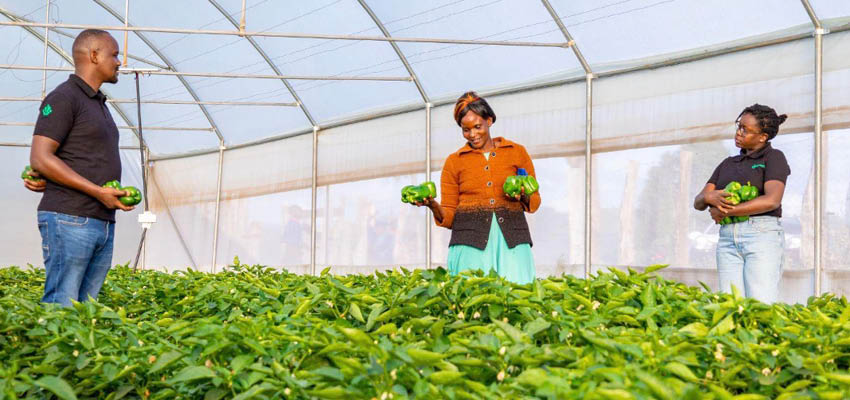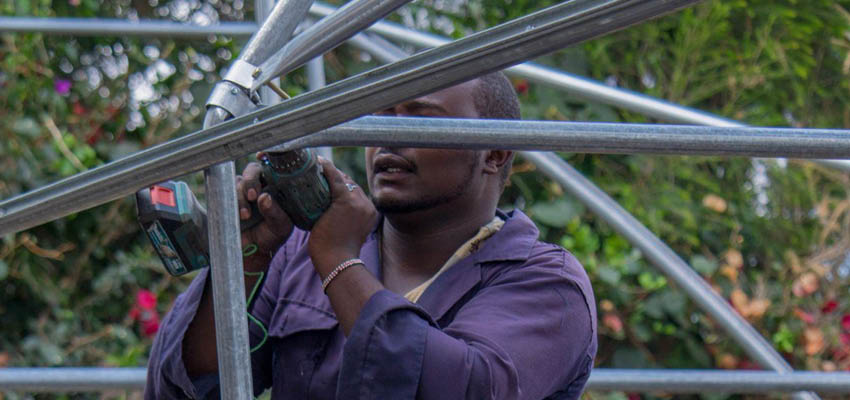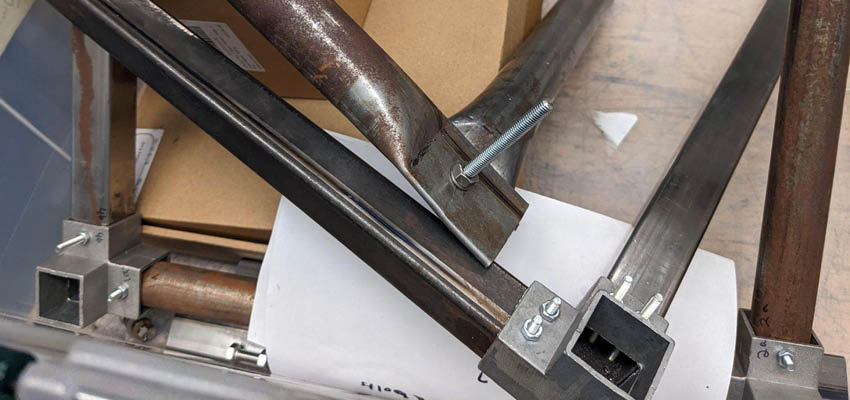
Improving climate resilience of Kenyan small-shareholder farmers through increasing ease of installing affordable greenhouses.
MIT D-Lab class
D-Lab: Leadership in Design (EC.725) - Spring 2024
Student team
MIT students unless otherwise noted.
- Kayla Brand '24, Wellesley College, Computer Science - Kayla Brand is an Albright Fellow and Gordon Engineering Leader who seeks to leverage her background in computer science to solve real world problems.
- Megan Gupta-She '25 - Megan Gupta-She is a Nuclear Engineering major with a concentration on materials who is passionate about integrated systems and engineering management.
- Faris Elnager '25 - Faris Elnager is a junior mechanical engineering student and Gordon Engineering Leader with a passion for Motorsports.
- Henry Smith '25 - Henry Smith is a junior studying mechanical engineering who enjoys learning on difficult projects.
Community partner
Synnefa
Eliminating risks and improving incomes for 1 million smallholder farmers in Sub-Saharan Africa.
We are grateful for our partnership with Taita Ngetich, CEO of Synnefa. Synnefa is based in Nairobi, Kenya.
Country
Kenya
Problem framing
Kenya’s agricultural sector employs more than 40% of the Kenyan population [10], and utilizes 49% [4] of Kenya’s land. Maize, rice, and wheat are Kenya’s top three staple crops, with maize being grown on 90% of Kenyan farms [7]. However, yields of maize is less than 2 tons per hectare in sub-Saharan Africa on average, one fifth the level produced per hectare in the United
States [9]. As a result, Kenya has to import US$50 billion in food annually [9]. Ninety-eight percent of Kenyan agriculture is rain-fed [2], leaving Kenyan farmers vulnerable to droughts and changing rainfall patterns. The IPCC predicts that climate change will reduce crop productivity in sub‐Saharan Africa by 5% for maize, 14% for rice, and 22% for wheat by 2050, pushing vulnerable people deeper into food insecurity and poverty [3].

Cultural context
When asked where their home is, most people in Nairobi name a rural town [6]. They have come into Nairobi to work and earn money for their families, and visit home with gifts once or twice a year [6]. To workers in Nairobi, Synnefa’s greenhouses can represent an opportunity to earn another stream of income, or protect their family’s crops back home [6]. Most farmers are small shareholders, and need to ensure their crops will produce a return every year.
After his own experience with crop failures, Taita Ngetich founded Synnefa eleven years ago in order to address challenges faced by low-income farmers and improve their socioeconomic mobility [5]. His greenhouses start at $300 and often cost $500 [8], one fifth the cost of the cheapest greenhouses in the United States [9]. These greenhouses have protected the crops of Pokot South farmer adopters, enabling all adopters to reliably pay educational fees to keep their children in schools [11]. To make his greenhouses so affordable, Mr. Ngetich sources manufacturing locally and makes customer value a core tenet of Synnefa. Metal stock is cut and bent in Kenya, trucked to a farm, and assembled on the spot with the help of artisan technicians who know where to drill holes for bolts [5]. However, the need for technicians increases costs and limits the accessibility of Synnefa greenhouses to many farmers who live far away from the technicians.

Proposed solution
We recommend the development of a manufacturing jig to consistently drill metal stock, enabling the fabrication of distinct sets of functionally identical pieces. Having exchangeable pieces that can be assembled according to an instruction manual or video would enable farmers to install their own greenhouses without requiring on-site artisan modification of the pieces, increasing access to Synnefa’s greenhouses.
Next steps
Next steps are to test and iterate our drilling jig prototype, clearly define the all distinct pieces that will be required for a greenhouse assembly kit, make jigs for each piece, confirm that each one is made within tolerance, and conduct user tests to measure the time or cost savings for farmers using a greenhouse assembly kit rather than working with artisan technicians. The artisans are an important stakeholder here, so further progress on this project should involve discussions with the artisans to ensure that this approach is mutually beneficial.
Sources
[1] Arul, Jerome, March 14, 2024.
[2] Conversation, The. “How to Save Farmers from Rain Dependency - FarmKenya Initiative.” Farm Kenya Initiative. Accessed April 30, 2024. https://www.standardmedia.co.ke/farmkenya/crop/article/2001470251/how-to-save-farmers-from-rain-dependency.
[3] Gebre, Girma Gezimu, Yuichiro Amekawa, Asmiro Abeje Fikadu, and Dil Bahadur Rahut. “Farmers′ Use of Climate Change Adaptation Strategies and Their Impacts on Food Security in Kenya.” Climate Risk Management 40 (2023): 100495. https://doi.org/10.1016/j.crm.2023.100495.
[4] “Kenya - Agricultural Land (% Of Land Area) - 2024 Data 2025 Forecast 1961-2021 Historical.” Accessed April 30, 2024. https://tradingeconomics.com/kenya/agricultural-land-percent-of-land-area-wb-data.html#:~:text=Agricultural%20land%20(%25%20of%20land%20area)%20in%20Kenya%20was%20reported,compiled%20from%20officially%20recognized%20sources.
[5] Ngetich, Taita, March 18, 2024.
[6] Ngetich, Towett, March 13, 2024.
[7] “Overview.” Accessed April 30, 2024. https://food.agricultureauthority.go.ke/index.php/sectors/overview.
[8] “Pricing.” Accessed April 30, 2024. https://synnefa.io/pricing.
[9] The Economist. “African Countries Must Get Smarter with Their Agriculture.” Accessed April 30, 2024. https://www.economist.com/special-report/2020/03/26/african-countries-must-get-smarter-with-their-agriculture.
[10] U.S. Agency for International Development. “Agriculture, Food and Water Security | Kenya,” June 5, 2023. https://www.usaid.gov/kenya/agriculture-food-and-water-security.
[11] “[Video] Synnefa: Helping Farmers Fight Climate Change | Synnefa Posted on the Topic | LinkedIn.” Accessed April 30, 2024. https://www.linkedin.com/posts/synnefake_climatechange-foodheroes-activity-7120706129063518209-tkb5.
Contact
Ankita Singh or Eliza Squibb, Co-Instructors Leadership in Design

